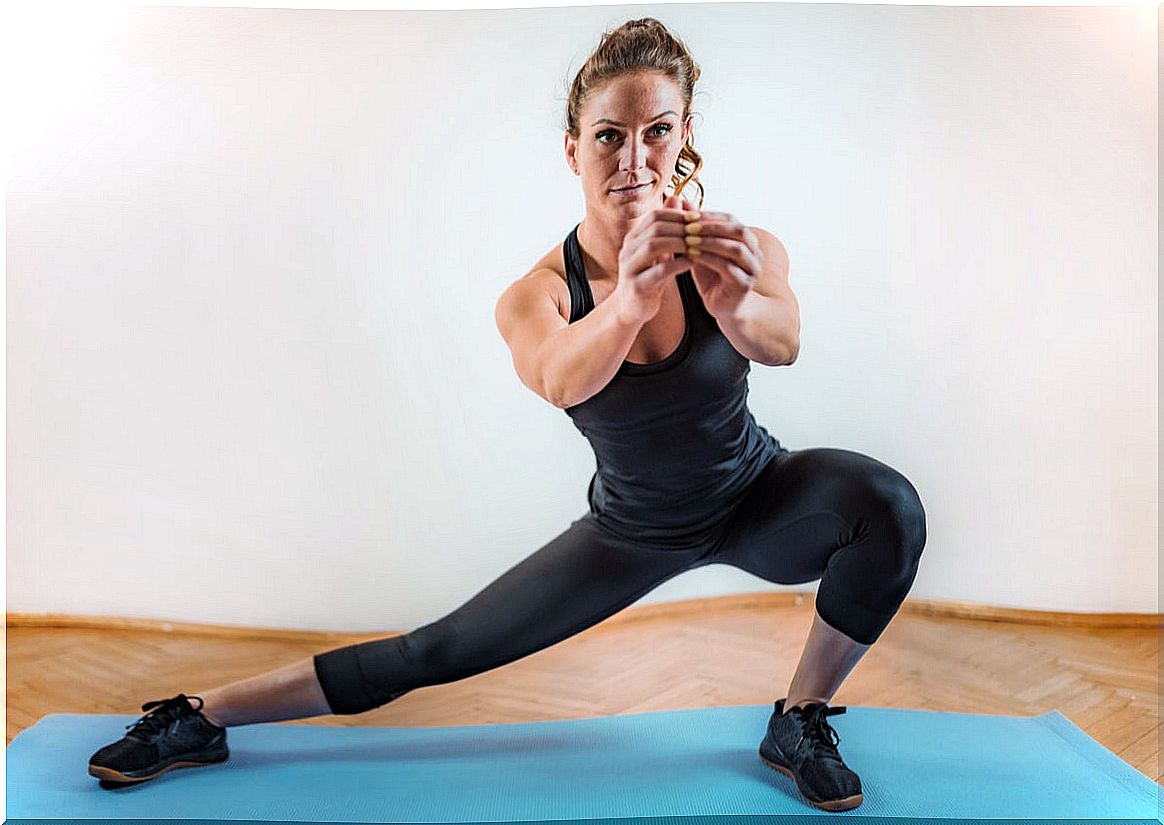HIIT Training: What Is It And What Are Its Benefits?
High intensity interval training ( HIIT ) is a form of cardiovascular exercise. It is done in short periods, alternating periods of high and low intensity. Its objective is to maximize athletic performance in conditions in which the muscles are deprived of oxygen.
This type of intense training causes a metabolic alteration that helps the body burn calories at a higher rate, even up to 48-72 hours later, which favors weight loss. In addition, it has many other benefits, such as cardiovascular improvement and regulation of blood glucose levels.
What is HIIT training?
HIIT training alternates short periods of intense anaerobic exercise with less intense recovery periods. Although there is no universal HIIT session duration, these intense workouts typically last less than 30 minutes. Regarding the duration of the intervals, these vary according to the current physical condition level of the participant.
HIIT training sessions often consist of a warm-up period. In fact, the more intense the routine, the more relevant it becomes, since the body needs to adapt.
This is followed by repetitions of high intensity exercises separated by medium intensity exercises as recovery. The exercises can always be the same or circuits can be performed with several different exercises.
In fact, the most important thing is to be able to maintain the intensity in the intervals of maximum work. Finally, a cool-down and cool-down period is included to gradually lower your heart rate, before stretching.
In this type of training, periods of high intensity must be performed almost to the maximum to use the anaerobic pathways (which break down glucose without oxygen) and thus produce energy.
This provides an immediate supply of energy, but the quantity is very limited. Therefore, the time that maximum effort can be maintained is quite short.
Since during periods of high intensity you work at submaximal intensities, recovering before the next interval is essential. It is precisely forcing the body to repeatedly accommodate itself between two very different states that provides excellent cardiovascular conditioning.

HIIT training benefits
The best-documented individual benefit of HIIT training has to do with cardiovascular health. In fact, growing research suggests that HIIT is a time-efficient exercise strategy to improve cardiorespiratory and metabolic health. In addition, this type of training has great benefits in relation to weight loss, among others.
Many calories are burned in a short time
HIIT not only helps you burn more calories than traditional exercise, but the same amount of calories can be burned in less time. This is perfect for those looking for an intense workout in a short time and for those who want to increase their caloric intake.
Various research supports this. For example, a study conducted with healthy men in 2015 found people can burn more calories performing a HIIT session than spending the same amount of time doing a steady-state exercise session.
Based on this research, this form of exercise is ideal for people who want to reap the benefits of cardio and resistance training, especially those with limited time to exercise. Another 2016 study found that during HIIT subjects burned more calories and reported less perceived exertion.
Improved metabolic rate up to 72 hours after exercise
Due to the intensity of training, HIIT can boost metabolism for up to 72 hours after exercise. This helps you burn more calories, even after you’ve finished your workout. In fact, several studies have shown this ability of HIIT to increase metabolic rate after exercise.
For example, a 2014 study, conducted to assess 24-hour oxygen consumption, found that oxygen consumption during HIIT was lower compared to continuous moderate-intensity training. However, the total oxygen consumption over 24 hours was similar.
According to the researchers, this shows that HIIT and continuous moderate intensity training induce a similar energy expenditure in 24 hours. In turn, this may explain the comparable changes in body composition despite a lower total training volume and time commitment.
Another study conducted with women in 2015 found that this exercise modality increased resting energy expenditure and caused a greater reduction in the respiratory exchange rate after exercise relative to other types of training, such as jogging and weight training.
The researchers also observed that HIIT shifts metabolism toward using fat for energy rather than carbohydrates. This, without a doubt, is interesting for people who are looking to lose weight.
Helps fight high insulin resistance in people with diabetes
A 2017 study found that high-intensity interval training quickly improves glucose metabolism in the muscles, as well as insulin sensitivity in type 2 diabetes.
The study determined that after just a two-week training period, glucose uptake in the thigh muscles returned to a normal level.
Another 2017 study shows that the majority of women at risk for type 2 diabetes show better metabolic and heart health metrics after a course of high-intensity interval training, with the greatest improvements in women at higher risk.
HIIT training, in general, improved all cardiometabolic health metrics. Women with greater insulin resistance had greater improvements in blood glucose and insulin measurements.
Helps to lose fat
This form of training produces a fat loss similar to that of traditional resistance exercise, even when the time spent on the routine is less. It also reduces the presence of unhealthy visceral fat, which is often difficult to eliminate.
In this regard, a study published in 2012 determined that, after 12 weeks, HIIT helped reduce total, abdominal, trunk and visceral fat. It was even helpful in increasing fat-free mass and aerobic power.
That same year, a publication in the International Journal of Obesity reported that these types of routines are effective for young overweight people. Therefore, they are considered to be an efficient component in weight management programs.

Helps improve maximum oxygen consumption (VO2max)
HIIT can improve maximal oxygen uptake or VO2max as much as traditional resistance training, even for shorter periods of time, as various research shows.
The maximum oxygen consumption is an important factor because it affects the physical capacity of your sports performance. With a higher VO2max, the body has better endurance in aerobic exercises. In turn, this helps you have better overall health.
May help improve heart rate and blood pressure
Research confirms that HIIT training can lower blood pressure and heart rate, especially in overweight or obese people with hypertension.
For example, a 2010 study found that high-intensity interval training can lower blood pressure more than moderate-intensity exercise, which is often recommended.
Another 2016 study found that eight weeks of HIIT training on a stationary bike lowered blood pressure as much as traditional continuous resistance training in adults with hypertension.
Disadvantages of HIIT training
One of the main drawbacks of HIIT is that it can be very intense at first. This can discourage many people who try it, especially those who are not in good previous physical shape and who start without professional advice.
This also increases the risk of injury, which is already quite high in itself. It should not be ignored that this practice is quite demanding and puts a lot of pressure on the body. Therefore, if a progressive program is not followed, it can cause contractures or discomfort.
According to a study published in the Journal of Sports Medicine and Physical Fitness , people who do high-intensity interval training have a higher risk of injury, especially to the knees and shoulders.
While that research recognized the benefits of this training, it noted that it increases the risk of nerve damage, internal organ injuries, puncture wounds, dislocations, strains and sprains.
To avoid this, experts suggest doing neuromuscular training, such as activities focused on strength, jumping, and balance. Pre-strengthening programs are also helpful to increase flexibility before starting HIIT exercises.
Recommendations to start the practice of HIIT
Before starting the practice of high intensity interval training (HIIT) it is important to be aware of your own physical abilities. People with low physical condition should start with short periods of high intensity. These periods should include easy-to-perform exercises, the technique of which is mastered to perfection.
Keep in mind that all exercises that involve impact, as well as those that require raising the arms above shoulder level, raise the pulse a lot. For this reason, this point must be controlled. For this, it is highly recommended to perform HIIT with a heart rate monitor and control the work zones well.









